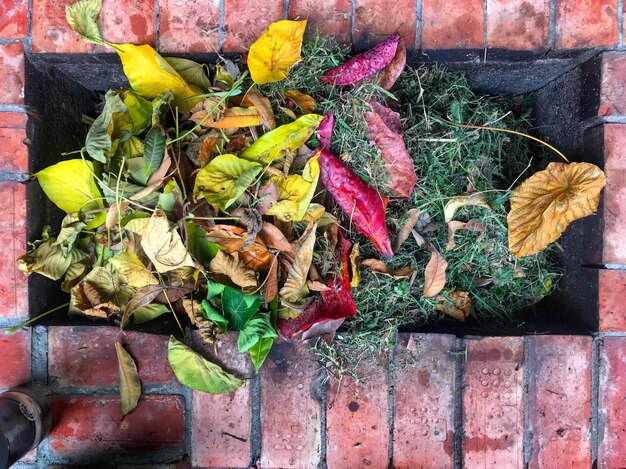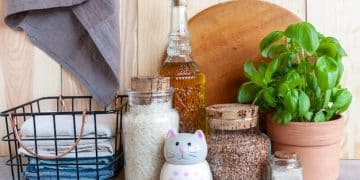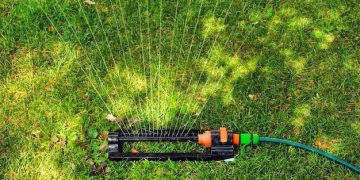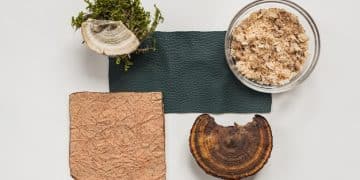Composting 101: Your Guide to Gold in the Garden

Composting 101 provides a comprehensive guide to transforming kitchen scraps and yard waste into nutrient-rich compost, enhancing your garden’s health and reducing landfill waste, creating a sustainable and eco-friendly lifestyle.
Ready to transform your trash into treasure? Composting 101: Turn Food Waste into Garden Gold is your guide to creating nutrient-rich soil for a thriving garden, all while reducing your environmental footprint.
What is Composting and Why Should You Do It?
Composting is nature’s way of recycling. It is the process of decomposing organic matter into a nutrient-rich substance called compost, or humus. This “black gold” can then be used to enrich garden soil, promoting healthier plant growth.
But why should you compost? The benefits are numerous and span from environmental to personal. Composting reduces landfill waste, decreases the need for chemical fertilizers, improves soil structure, and conserves water. It’s a win-win for you and the planet.
Environmental Benefits of Composting
Composting plays a crucial role in mitigating environmental issues. Here’s how:
- Reduces Landfill Waste: A significant portion of household waste is organic matter. Composting diverts this waste from landfills, reducing methane emissions, a potent greenhouse gas.
- Decreases Need for Chemical Fertilizers: Compost is a natural fertilizer, rich in essential nutrients. By using compost, you reduce your reliance on synthetic fertilizers, which can harm beneficial soil organisms and pollute waterways.
- Conserves Water: Compost improves soil’s water retention capacity, meaning you need to water your garden less frequently. This conserves water and reduces your water bill.
By embracing composting, you’re not just gardening; you’re actively participating in a healthier, more sustainable future.
Choosing the Right Composting Method for You
There are several composting methods, each with its own advantages and considerations. The best method for you depends on your space, time commitment, and the amount of waste you generate.
Let’s explore some popular composting methods to help you find the perfect fit for your lifestyle.

Types of Composting Methods
- Backyard Composting: This traditional method involves creating a compost pile or bin in your backyard. It’s ideal for those with yard space and a steady supply of organic waste.
- Vermicomposting (Worm Composting): This method uses worms to break down organic matter. It’s perfect for apartment dwellers or anyone with limited space, as it can be done indoors.
- Bokashi Composting: This anaerobic fermentation process uses inoculated bran to ferment food waste, including meat and dairy. It’s a great option for those who want to compost all types of food scraps.
Consider your space, time, and the types of waste you want to compost when choosing a method. Each offers a unique approach to turning waste into valuable compost.
Setting Up Your Compost Bin or System
Once you’ve chosen a composting method, it’s time to set up your system. Whether you’re building a traditional compost bin or setting up a worm bin, the right setup is crucial for success.
Let’s dive into the essentials of setting up your composting system for optimal results.
Building a Backyard Compost Bin
Building a backyard compost bin can be a simple DIY project. Here are some basic steps:
- Choose a Location: Select a spot in your yard that is well-drained and receives partial shade.
- Build or Buy a Bin: You can build a bin from wood, pallets, or wire mesh, or purchase a pre-made compost bin.
- Layer Materials: Start with a layer of coarse materials like twigs or straw, followed by alternating layers of “greens” (nitrogen-rich materials) and “browns” (carbon-rich materials).
A well-constructed compost bin provides the ideal environment for decomposition, ensuring your compost pile thrives.
What to Compost: Greens vs. Browns
Understanding the balance between “greens” and “browns” is fundamental to successful composting. These materials provide the necessary carbon and nitrogen for decomposition.
Let’s explore what falls into each category and how to maintain the right ratio for a healthy compost pile.
Examples of Greens and Browns
- Greens (Nitrogen-Rich):
- Fruit and vegetable scraps
- Coffee grounds
- Grass clippings
- Manure
- Browns (Carbon-Rich):
- Dry leaves
- Shredded paper
- Cardboard pieces
- Twigs and branches
The ideal ratio is typically 2:1 or 3:1 browns to greens. This balance ensures proper aeration and prevents odors, creating an optimal environment for decomposition.

Troubleshooting Common Composting Problems
Composting isn’t always smooth sailing. You might encounter issues like foul odors, slow decomposition, or pest infestations. Don’t worry; most problems are easily fixable.
Let’s address some common composting challenges and how to overcome them.
Common Composting Issues and Solutions
- Foul Odors:
- Problem: Anaerobic conditions (lack of oxygen).
- Solution: Turn the pile more frequently to aerate it. Add more brown materials to absorb excess moisture.
- Slow Decomposition:
- Problem: Lack of moisture or insufficient nitrogen.
- Solution: Moisten the pile regularly. Add more green materials to increase nitrogen levels.
- Pest Infestations:
- Problem: Attracting rodents or insects.
- Solution: Avoid composting meat, dairy, and oily foods. Ensure the compost bin is sealed properly.
With a little troubleshooting, you can keep your compost pile healthy and productive, turning waste into valuable garden gold.
Using Your Compost: Application Tips
Once your compost is ready, it’s time to put it to use in your garden. Compost can be used in various ways to improve soil health and boost plant growth.
Let’s explore the best ways to apply compost to your garden for maximum benefits.
Ways to Use Compost in Your Garden
Compost is a versatile soil amendment. Here are some application tips:
- Soil Amendment: Mix compost into garden beds before planting to improve soil structure, drainage, and nutrient content.
- Top Dressing: Spread a layer of compost around existing plants to gradually release nutrients and suppress weeds.
- Potting Mix: Incorporate compost into your potting mix for container plants to provide essential nutrients and improve water retention.
By using compost effectively, you’ll not only nourish your plants but also create a thriving, sustainable garden ecosystem.
| Key Point | Brief Description |
|---|---|
| ♻️ What is Composting | Natural recycling process turning organic waste into nutrient-rich soil. |
| 🌱 Benefits | Reduces landfill waste, decreases chemical fertilizer use, conserves water. |
| 🍂 Greens & Browns | Balance nitrogen-rich (greens) and carbon-rich (browns) for optimal decomposition. |
| 👍 Troubleshooting | Address odors, slow decomposition, and pests with simple solutions. |
Frequently Asked Questions About Composting
▼
Avoid composting meat, dairy, oily foods, and diseased plants as they can attract pests and create unpleasant odors. These materials may also introduce harmful pathogens into your compost pile.
▼
The composting process can take anywhere from a few months to a year, depending on the method and materials used. Regular turning and maintaining the right moisture balance can speed up decomposition.
▼
Finished compost should be dark, crumbly, and have a earthy smell. It should also be free of recognizable food scraps or yard waste. The texture should be uniform throughout the pile.
▼
Yes! Vermicomposting (worm composting) is a great option for apartment dwellers. It’s compact, odorless (when done correctly), and can be done indoors. Bokashi composting is another suitable option for apartment living.
▼
The ideal carbon to nitrogen ratio for composting is around 25:1 to 30:1. This balance ensures proper aeration and prevents odors while supporting microbial activity for efficient decomposition.
Conclusion
Composting is a rewarding and sustainable practice that benefits both your garden and the environment. By following these tips and understanding the basics, you can transform food waste into valuable garden gold, contributing to a healthier planet and a thriving garden.





